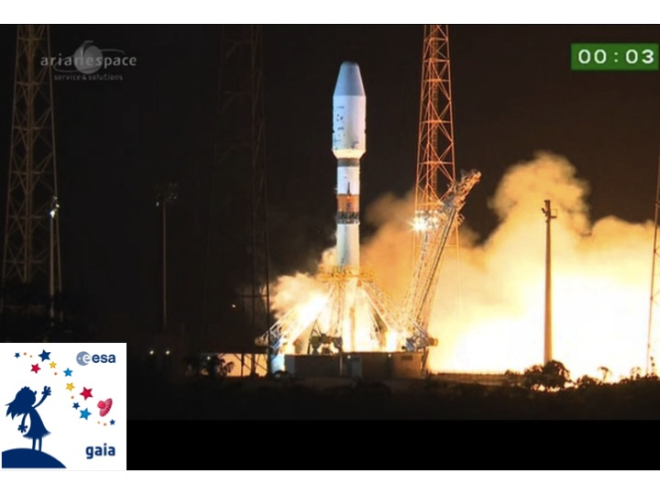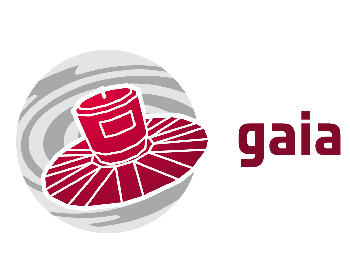The GAIA mission
Overview
The ESA Gaia space mission is a major project for the European astronomical community which will deeply change our view of the Galaxy with a precise and detailed stereoscopic survey of the billion brightest celestial objects. Gaia will perform a 5 years all-sky scanning survey that will provide accurate μas astrometry (more than 100 times better than Hipparcos, the first space-based astrometry mission). This very high-accuracy astrometry will allow Gaia to measure the 3D position of a star and its movement across the sky. Gaia will also gather spectroscopic data, allowing radial velocities to be determined for several millions of galactic stars, and spectro-photometric data, measuring the astrophysical properties including luminosity, surface gravity, temperature and chemical composition.
Gaia was launched on December 19th, 2013 by a Soyuz-Fregat launch vehicle from the European Spaceport in Kourou, French Guiana (figure 1), and operates in the vicinity of the second Lagrange point (L2), approximately 1.5 million km from the Earth, along the Sun-Earth line in the direction opposite to the Sun.
During its 5-year operational lifetime, the satellite will continuously spin around its axis, with a constant speed of 60 arcsec/sec, covering the full sky in about 6 months. Each of the Gaia targets will be therefore scanned from a minimum of approximately 10 times to a maximum of 250 times.
A full and detailed description of the Gaia mission is available at:
http://www.cosmos.esa.int/web/gaia
SSDC contribution
SSDC CONTRIBUTION IN CU9
The Gaia catalogue will be one of the largest and richest astronomical catalogues ever realized.
SSDC is coordinating the Italian contribution to DPAC-CU9, the coordination unit that will be responsible for the realization of the Catalogue and the release of the Gaia data. In the framework of a wide international collaboration, SSDC will host a copy of the Gaia catalogue and will contribute to CU9 activities. SSDC is developing access, data extraction, data mining tools to enable the astronomical community to handle and fully exploit the scientific potential of this enormous archive. In addition, SSDC will be responsible for the cross-match of the Gaia catalogue with the largest public available optical and near-IR catalogues and several other catalogues from radio to X-ray domain, ensuring an all-sky, multi-wavelength panchromatic vision of the universe.
SSDC CONTRIBUTION IN CU5
SSDC is also deeply involved in DPAC-CU5, the coordination unit responsible for the analysis of the Gaia spectrophotometric data. SSDC is developing the software for the data reduction of the crowded fields. Finally, SSDC is building the archive and database of the ancillary data produced by the Italian teams involved in Gaia, that is the collection of all the measurements, observations and simulations required for the reduction and absolute calibration of Gaia spectro-photometric observations.

Fig.1: Snapshot of Gaia Launch with Gaia fairing logo (Copyright:ESA)

